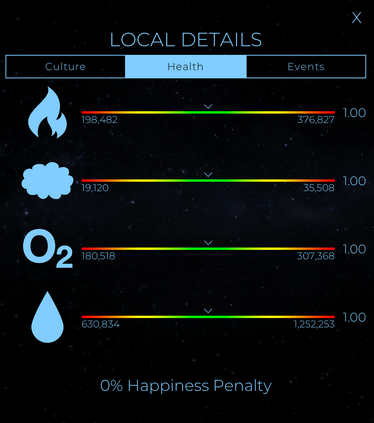
|
Featured Article
This article is one of the wiki's key articles. It is therefore a featured article |

Your citizens have made first contact with the natives of [village]! Nothing is certain, of course, but we hope to establish a good relationship with this new and fascinating society.
Introduction[]

How To Make Contact With Natives - TerraGenesis Tutorials
Native Civilizations were first introduced in the 5.0 update and are the focal point of Chibania in the Historical Earths campaign.[1] Additionally, a random event on Earth (Native Civilization Detected) can also reveal an uncontacted native tribe of homo sapiens (i.e., human). Players are also ~25% likely to encounter Natives while generating random planets.
The Natives mechanic in TerraGenesis forces players to take on the role of an alien civilization settling an already occupied world — perfectly suited for the Native species, but inhospitable for humans. Will players terraform the world to human specifications at the cost of Native lives? Or will humans remain in domed cities, perpetual visitors in this strange land?
There is a long list of missions players can perform to change a village's familiarity levels, happiness levels, population levels, aggression levels, and infrastructure levels.
Events can influence these stats as well.
There are also missions that can grant peace or trade treaties between natives and humans societies. Trade treaties generate large amounts of revenue for the player.
A number of missions are only available if the prerequisites for them have been met, so don't panic if some of the missions on the list below don't appear on the list — they will appear once players meet their prerequisites.
Missions take 30 minutes to complete, but this time can be skipped by using Genesis Points. The first mission to be performed on a village costs 50,000c, and each consecutive mission costs 50,000c more than the last one. Only one mission can be performed per village at a time, so new missions can only be started after the current mission has been completed.
Missions have a chance of success which depends on how risky the mission itself is, which can be dependent upon player familiarity, the village's local happiness, etc.
- Main article: Native Civilization/Mission Chance of Success
Local Happiness is basically how much the village likes the player's civilization. Familiarity is how much players know about the individual village. Although familiarity can only ever go up, Happiness can increase or decrease depending on player actions.
Familiarity scores start at 5% and can go up through undertaking missions.
Culture[]
On the Culture tab players can see the familiarity with a village, as well as their local happiness, and a couple of basic facts about them that player will find out through interacting with them. The higher the village's familiarity score, the more players will come to know about them, beginning with Foreign Policy, followed by Infrastructure Level, then Religion, Social Structure, and finally Government Structure. Species Classification and Scientific Name are given at the start.
- Species Classification — Mammalian/Reptilian/Avian/Insectoid/Unclassifiable
- Scientific Name — Homininae Hominini (Chibania)/(on random planets, this is infinite and randomized)
- Foreign Policy — Pacifist/Defensive/Neutral/Aggressive/Hyper-Aggressive
- Infrastructure Level — Stone Age/Bronze Age/Iron Age/Pre-Industrial/Industrial
- Religion — Animism/Ancestor Worship/Shamanism/Dualism/Philosophy/Monotheism/Polytheism/Atheism
- Social Structure — Tribalism/Gerontocracy/Matriarchy/Patriarchy/Egalitarianism
- Government Structure — Anarchy/Despotism/Oligarchy/Monarchy/Democracy/Plutocracy/Commune/Theocracy/Republic
Foreign policy only matters in the first contact missions. Other than that, mission outcomes and chances of success will depend on happiness and familiarity, (NOTE: there are no true war mechanics in TerraGenesis, so Natives won't attack the settlers).
Infrastructure Level matters for the amount of credits a Trade Treaty with the village earns.
Villages with a higher level of infrastructure will spawn into new worlds with more population than villages with a lower level of infrastructure.
| Default Infrastructure Level | Population |
|---|---|
| Stone Age | ~100–250 |
| Bronze Age | ~1,000–2,500 |
| Iron Age | ~10,000–25,000 |
| Pre-Industrial | ~100,000–250,000 |
| Industrial | ~1,000,000–2,500,000 |
Health[]

The Health tab shows how well the world's climate is suited to the village. They will become less healthy if changes planetary stats too much, and they die off if any of their health stats reaches 0. If playing as the Daughters of Gaia on an extraterrestrial world with Natives, achieving Paradise stats is all but guaranteed to kill off the planet's original inhabitants (under most circumstances), and United Nations Space Administration are in a tricky place too, as increasing the planet’s population is quite impractical without achieving habitable stats if the planet spawns only supporting plant life. Remember, Natives don't have Hab facilities to hide in when the planet becomes terraformed for humans but uninhabitable for them (unless they receive The Shield).
The health tab starts with each planetary stat perfectly suited to the Natives. Heat, Pressure, Oxygen, and Water all have a 1.00 written next to them, which is the best score possible. If change the planetary stats at all, the 1.00 will start getting closer to 0.00, and the pointer will start moving away from the green area into the red area. If any of the planetary stat reaches 0.00, all Natives not protected by a Shield immediately die, like the ecological collapse.
Health also affects a village's Happiness score. Basically, if players choose to terraform their planet, thereby killing them off, they will not like humans very much.
An example is if a village with a base Happiness score of 90% has its Heat at 0.80, Pressure at 0.50, and the other two stats at 1.00. In this case, the Pressure is 50% off of what it should be, so base Happiness will be reduced by 50%. Therefore, the Happiness score will then be half of 90%, which is 45%.
Events[]
The Events tab is a list of effects that events or missions that have happened, For example, it could list 'plague' and 'peace treaty' if those events have happened. It is kind of like the 'Local Culture' tab located in 'Examine [City].'
A list of events specific to worlds with Native Civilizations can be found here:
- Main article: Native Civilization/Events
First Contact[]
- Main article: Native Civilization/First Contact
Stealth Missions[]

Covert operations: high risk, high reward.
- Main article: Native Civilization/Stealth Missions
Diplomacy Missions[]

The beginning of a peaceful coexistence.
- Main article: Native Civilization/Diplomacy Missions
Conquest Missions[]

Enforce your will, at any cost.
- Main article: Native Civilization/Conquest Missions
Strategy[]
The Scouting Ahead method while making first contact sounds good at first, but it's about as risky as the other two — 50% either way isn't the best odds.
After making contact, it is wise to do some Reconnaissance and The Grand Tour missions to crank up the familiarity score. At this point, any other missions are too risky and likely to fail.
If Happiness/Familiarity scores are abysmal, making friends with the village isn't impossible, but it will be expensive. Focus on missions that increase familiarity, which cannot be lost once it's been gained. Protection Money is always 95% success chance and can be repeated infinitely, increasing Familiarity by 2 points each time. After increasing Familiarity, go for The Pen is Mightier. This will eventually max out both Familiarity and Happiness.
A risky and pretty evil, but also pretty effective, method of quickly increasing happiness is to do a Death on the Wind followed by a The Cure. There is a 67.5% chance of neither mission failing.
Trivia[]
- On Earth, players will randomly stumble upon Native Civilizations yet not experience the ethical quandary of terraforming since they are human.
- In real life, first contact is extremely dangerous for Natives, since they don't have antibodies to a lot of common diseases that we carry with us without them harming us (because of our immunities). Whenever a tribe is contacted for the first time, there is a very large risk of most of them dying from diseases.
- Some uncontacted tribes still exist in remote places, such as the Amazonian rainforest, and whether or not we should contact them is a very controversial topic, not only because of the risks associated with it, but also because they can't ever go back to being uncontacted. And we can't exactly ask them whether they'd like to be contacted before we contact them. Who are we to make that decision for them?
- Population growth of Natives is abysmally slow — an increase of around 0.000083% (1/1200000) every two seconds.
- Setting the device clock forward in time can be used to get to infinity Natives — a population of about 1.8×10108 — which is the double floating point integer limit. Credits will also go to positive infinity at that point if any trade treaties are active.
- When a mission fails, no matter what mission it is, there is always a +1% to familiarity despite it not saying that in the failure effects. This is because the Natives have become familiar with us through our failure, sort of like watching a video of a celebrity falling and their image being affected by that.
- In version 6.35, happiness can reach 105% due to a bug.
| Worlds | |
|---|---|
| Terrestrial Planets | Mercury · Venus · Earth · Moon (Luna) · Mars |
| Moons of Giant Planets | Moons of Jupiter • Moons of Saturn • Moons of Uranus • Moons of Neptune |
| Moons of Jupiter | Io · Europa · Ganymede · Callisto |
| Moons of Saturn | Tethys · Dione · Rhea · Titan · Iapetus |
| Moons of Uranus | Miranda · Ariel · Umbriel · Titania · Oberon |
| Moons of Neptune | Triton |
| Dwarf Planets | Ceres · Pluto · Charon · Makemake · Eris · Sedna |
| TRAPPIST-1 | Damu · Aja · Huanca · Ruaumoko · Asintmah · Ostara · Aranyani |
| Fictional Planets | Bacchus · Pontus · Lethe · Ragnarok · Boreas |
| Historical Earths | Vaalbara · Rodinia · Cambria · Cretacea · Dania · Chibania · Ultima |
| Random Planets | ∞ |
